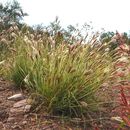Comprehensive Description
provided by North American Flora
Trichloris mendocina (Philippi) Kurtz, Mem. Fac. Ci. Univ Cordoba 1896: 37. 1897.
Ckloris mendocina Philippi, Anal. Univ. Chile 36: 208. 1870. {Type from Mendoza, Argentina
[Philippi].) Trichloris (?) Blanchardiana Fourn.; Scribn. Bull. Torrey Club 9: 146. 1882. (Type from Tucson.
Arizona, PringU.) Chloridiopsis [error for Chloropsis] Blanchardiana Gay; Scribn. Bull. Torrey Club 9: 146, as synonym
of Trichloris Blanchardiana Fourn. 1882. Trichloris verlicillala Fourn.; Vasey, Cat. Grasses U. S. 61, name only. 1885; Bull. U. S. Dep. Agr.
Bot. 12': no. 25. 1891. (Type from Tucson, Arizona, Pr<n;5ie.) Trichloris fasciculata Fourn. Mex. PI. Gram. 2: 142. 1886. (Type from San Luis de Potosl, Mexico,
VirUt 1440.) Chloropsis Blanchardiana Kuntze, Rev. Gen. 771. 1891 . (Based on Trichloris Blanchardiana Hack.
[error for Fourn.]) Chloropsis fasciculata Kuntze, Rev. Gen. 771. 1891. (Based on Trichloris fasciculata Fourn.) Chloropsis mendocina Kuntze, Rev. Gen. 3': 348. 1898. (Based on Chloris mendocina Philippi.) Leptochloris Greggii Munro; Merrill, Circ. U. S. Dep. Agr. Agrost. 32: 7, as synonym of Chloropsis
mendocina Kuntze. 1901.
Culms erect, or sometimes decumbent at the base, branching, 40-80 cm. tall; sheaths compressed-keeled, the lower ones much longer than the internodes, glabrous; ligule ciliate, 1 mm. long; blades 10-25 cm. long, 2-4 mm. wide, conduplicate, attenuate, scabrous, sparsely to densely pilose on the upper surface toward the base; spikes 10-18, 5-12 cm. long, crowded, closely appressed, the spikelets hidden by the numerous awns; glumes acute, the first about 1 mm. long, short-awned, the second 1.5 mm. long, the awn 1.5-3 mm. long; lemma of the fertile floret 3 mm. long, the 3 slender awns 10 mm. long, scabrous; awns of the rudimentary floret shorter than those of the fertile lemma.
TvpB locality: Mendoza, Argentina (Philippi).
Distribution: Plains and rocky hills, western Texas to Arizona; northern Mexico; also in Paraguay, Bolivia, and Argentina.
- bibliographic citation
- Albert Spear Hitchcock, Jason Richard Swallen, Agnes Chase. 1939. (POALES); POACEAE (pars). North American flora. vol 17(8). New York Botanical Garden, New York, NY
Physical Description
provided by USDA PLANTS text
Perennials, Terrestrial, not aquatic, Stolons or runners present, Stems nodes swollen or br ittle, Stems erect or ascending, Stems caespitose, tufted, or clustered, Stems terete, round in cross section, or polygonal, Stem internodes hollow, Stems with inflorescence less than 1 m tall, Stems, culms, or scapes exceeding basal leaves, Leaves mostly basal, below middle of stem, Leaves mostly cauline, Leaves conspicuously 2-ranked, distichous, Leaves sheathing at base, Leaf sheath mostly open, or loose, Leaf sheath smooth, glabrous, Leaf sheath hairy, hispid or prickly, Leaf sheath or blade keeled, Leaf sheath and blade differentiated, Leaf blades linear, Leaf blades 2-10 mm wide, Leaf blade margins folded, involute, or conduplicate, Leaf blades mostly glabrous, Leaf blades scabrous, roughened, or wrinkled, Ligule present, Ligule a fringe of hairs, Inflorescence terminal, Inflorescence solitary, with 1 spike, fascicle, glomerule, head, or cluster per stem or culm, Inflorescence a panicle with narrowly racemose or spicate branches, Inflorescence a panicle with digitatel y arranged spicate branches, Inflorescence with 2-10 branches, Inflorescence branches more than 10 to numerous, Lower panicle branches whorled, Inflorescence branches paired or digitate at a single node, Flowers bisexual, Spikelets sessile or subsessile, Spikelets laterally compressed, Spikelet less than 3 mm wide, Spikelets with 1 fertile floret, Spikelets solitary at rachis nodes, Spikelets all alike and fertille, Spikelets bisexual, Spikelets disarticulating above the glumes, glumes persistent, Spikelets disarticulating beneath or between the florets, Spikelets secund, in rows on one side of rachis, Rachilla or pedicel glabrous, Glumes present, empty bracts, Glumes 2 clearly present, Glumes equal or subequal, Glumes shorter than adjacent lemma, Glumes keeled or winged, Glumes 1 nerved, Lemmas thin, chartaceous, hyaline, cartilaginous, or membranous, Lemma coriaceous, firmer or thicker in texture than the glumes, Lemma 3 nerved, Lemma glabrous, Lemma body or surface hairy, Lemma apex acute or acuminate, Lemma distinctly awned, more than 2-3 mm, Lemma with 3 awns, Lemma awns about equal in length, Lemma awn less than 1 cm long, Lemma awn 1-2 cm long, Lemma awned from tip, Lemma awns straight or curved to base, Lemma margins thin, lying flat, Lemma straight, Callus or base of lemma evidently hairy, Callus hairs shorter than lemma, Palea present, well developed, Palea membranous, hyaline, Palea shorter than lemma, Palea about equal to lemma, Palea 2 nerved or 2 keeled, Stamens 2, Stamens 3, Styles 2-fid, deeply 2-branched, Stigmas 2, Fruit - caryopsis, Caryopsis ellipsoid, longitudinally grooved, hilum long-linear.
Trichloris crinita: Brief Summary
provided by wikipedia EN
Trichloris crinita is a species of grass known by the common name false Rhodes grass. It is native to the Americas, where it occurs in the southwestern United States, northern Mexico, and parts of Argentina.
This perennial grass reaches up to 1 meter tall. It sometimes spreads via stolons. The rough-haired leaves are up to 20 centimeters long by 1 centimeter wide. The panicle is a cluster of up to 20 branches arranged in tight whorls. Each branch is up to 15 centimeters long and lined with tiny spikelets. Each spikelet has one bisexual and one or two sterile flowers.
This species is a common forage grass on dry plains in Argentina. In the US it is used for range revegetation.
- license
- cc-by-sa-3.0
- copyright
- Wikipedia authors and editors

